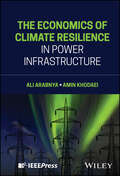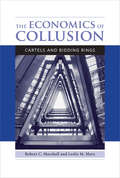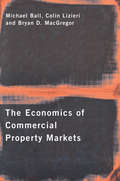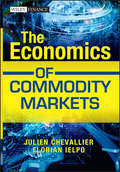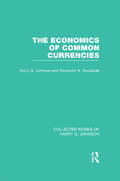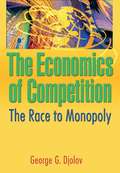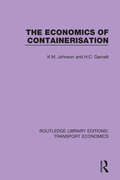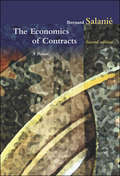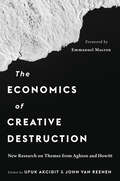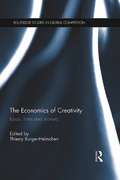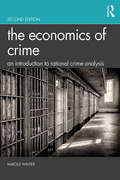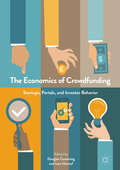- Table View
- List View
The Economics of Climate Change and the Change of Climate in Economics
by Kevin MaréchalClimate change is without question the single most important issue the world faces over the next hundred years. The most recent scientific data have led to the conclusion that the globally averaged net effect of human activities since 1750 has been one of warming and that continued greenhouse gas emissions at or above current rates would cause this process to continue to the severe detriment of our environment. This unequivocal link between climate change and human activity requires an urgent, world-wide shift towards a low carbon economy and coordinated policies and measures to manage this transition. The starting point and core idea of this book is the long-held observation that thethreat of climate change calls for a change of climate in economics. Inherent characteristics of the climate problem including complexity, irreversibility and deep uncertainty challenge core economic assumptions and mainstream economic theory appears inappropriately equipped to deal with this crucial issue. Kevin Maréchal shows how themes and approaches from evolutionary and ecological economics can be united to provide a theoretical framework that is better suited to tackle the problem.
The Economics of Climate Resilience in Power Infrastructure
by Amin Khodaei Ali ArabnyaFull-scope economic perspectives on planning, operations management, and maintenance of climate resilience building measures in power infrastructure The Economics of Climate Resilience in Power Infrastructure sheds light on the engineering economics of climate adaptation in electric power infrastructure by covering the relevant decision-making processes involved in managing risk and resilience in these systems. The book offers a system-level perspective along with detailed modeling of the most pressing resilience issues, while also providing detailed numerical examples on small test systems throughout the text to help readers see the outcomes of models. The book starts with an introduction to risk management and the techno-economic considerations for resilience building measures in power systems. Next, economic concepts and mechanisms for managing climate risk in power systems are introduced. Afterward, an economic model for resilience investment in these systems against climate shocks is presented. The authors then discuss an economic asset management model for long-term resilience building in critical infrastructure assets. Subsequently, an economic model for operations management during disasters is proposed, followed by a model for post-disaster restoration. Written by a pair of distinguished thought leaders, the book explores other topics such as: Microgrid applications for decentralization, along with an economic model for resilience-oriented microgrid operations A deep defense framework for climate risk management in power systems, along with other factors influencing their operational and financial resilience Essential climate risk financing mechanisms and techno-economic factors in managing risk and resilience in the face of wildfires, heat waves, and hurricanes Steps for utility and infrastructure owners to recover from climate shocks and natural disasters, for the benefit of shareholders, ratepayers, and policymakers The Economics of Climate Resilience in Power Infrastructure is an essential resource on the subject for industry practitioners, R&D engineers, infrastructure planners, and graduate students seeking to incorporate the economics of resilience with engineering solutions to streamline the success of climate adaptation measures in the power and energy industry.
The Economics of Collusion
by Robert C. Marshall Leslie M. MarxExplicit collusion is an agreement among competitors to suppress rivalry that relies on interfirm communication and/or transfers. Rivalry between competitors erodes profits; the suppression of rivalry through collusion is one avenue by which firms can enhance profits. Many cartels and bidding rings function for years in a stable and peaceful manner despite the illegality of their agreements and incentives for deviation by their members. In The Economics of Collusion, Robert Marshall and Leslie Marx offer an examination of collusive behavior: what it is, why it is profitable, how it is implemented, and how it might be detected. Marshall and Marx, who have studied collusion extensively for two decades, begin with three narratives: the organization and implementation of a cartel, the organization and implementation of a bidding ring, and a parent company's efforts to detect collusion by its divisions. These accounts--fictitious, but rooted in the inner workings and details from actual cases--offer a novel and engaging way for the reader to understand the basics of collusive behavior. The narratives are followed by detailed economic analyses of cartels, bidding rings, and detection. The narratives offer an engaging entrée to the more rigorous economic discussion that follows. The book is accessible to any reader who understands basic economic reasoning. Mathematical material is flagged with asterisks.
The Economics of Collusion: Cartels and Bidding Rings
by Robert C. Marshall Leslie M. MarxAn examination of collusive behavior: what it is, why it is profitable, how it is implemented, and how it might be detected.Explicit collusion is an agreement among competitors to suppress rivalry that relies on interfirm communication and/or transfers. Rivalry between competitors erodes profits; the suppression of rivalry through collusion is one avenue by which firms can enhance profits. Many cartels and bidding rings function for years in a stable and peaceful manner despite the illegality of their agreements and incentives for deviation by their members. In The Economics of Collusion, Robert Marshall and Leslie Marx offer an examination of collusive behavior: what it is, why it is profitable, how it is implemented, and how it might be detected.Marshall and Marx, who have studied collusion extensively for two decades, begin with three narratives: the organization and implementation of a cartel, the organization and implementation of a bidding ring, and a parent company's efforts to detect collusion by its divisions. These accounts—fictitious, but rooted in the inner workings and details from actual cases—offer a novel and engaging way for the reader to understand the basics of collusive behavior. The narratives are followed by detailed economic analyses of cartels, bidding rings, and detection.The narratives offer an engaging entrée to the more rigorous economic discussion that follows. The book is accessible to any reader who understands basic economic reasoning. Mathematical material is flagged with asterisks.
The Economics of Commercial Property Markets
by Michael Ball Colin Lizieri Bryan MacGregorThis new text provides a rigorous analysis of real estate markets. Three main sections cover: microeconomics of property markets the macroeconomics of commercial property the financial economics of property Global empirical examples illustrate the theories and issues. This often complex area is made accessible: each chapter contains a boxed summary and questions for self-testing or discussion.
The Economics of Commodity Markets
by Julien Chevallier Florian IelpoAs commodity markets have continued their expansion an extensive and complex financial industry has developed to service them. This industry includes hundreds of participating firms, including asset managers, brokers, consultants, verification agencies and a myriad of other institutions. Universities and other training institutions have responded to this rapid expansion of commodity markets as well as their substantial future growth potential by launching specialized courses on the subject. The Economics of Commodity Markets attempts to bridge the gap between academics and working professionals by way of a textbook that is both theoretically informative and practical. Based in part on the authors' teaching experience of commodity finance at the University Paris Dauphine, the book covers all important commodity markets topics and includes coverage of recent topics such as financial applications and intuitive economic reasoning. The book is composed of three parts that cover: commodity market dynamics, commodities and the business cycle, and commodities and fundamental value. The key original approach to the subject matter lies in a shift away from the descriptive to the econometric analysis of commodity markets. Information on market trends of commodities is presented in the first part, with a strong emphasis on the quantitative treatment of that information in the remaining two parts of the book. Readers are provided with a clear and succinct exposition of up-to-date financial economic and econometric methods as these apply to commodity markets. In addition a number of useful empirical applications are introduced and discussed. This book is a self-contained offering, discussing all key methods and insights without descending into superfluous technicalities. All explanations are structured in an accessible manner, permitting any reader with a basic understanding of mathematics and finance to work their way through all parts of the book without having to resort to external sources.
The Economics of Common Currencies: Proceedings of the Madrid Conference on Optimum Currency Areas (Collected Works of Harry G. Johnson)
by Robert A. MundellGathering together the papers presented at the Madrid Conference on Optimum Currency Areas in 1970 this volume represents one of the first complete surveys of the theory and policy implication of monetary integration. The book discusses: the economics of fixed exchange rates relevant to monetary relations within an integrated monetary area the evolution of economic doctrine and a survey of optimum currency area theory problems of policy co-ordination within a currency area relevance of the monetary-fiscal policy mix problems of monetary union in developing countries the book predicted the establishment of an European currency but presented the case for greater flexibility of exchange rates as an alternative to currency unification.
The Economics of Competition, Collusion and In-between
by Claude d’Aspremont Rodolphe Dos Santos FerreiraThis book provides a methodology for the analysis of oligopolistic markets from an equilibrium viewpoint, considering competition within and between groups of firms. It proposes a well-founded measure of competitive toughness that can be used in empirically relevant applications. This measure reflects the weight put by each firm on competition for market share relative to competition for market size – two dimensions of competition involving conflicting and convergent interests, respectively. It further explores several applications, such as the effect of tougher competition on innovation and of output market power on the emergence of involuntary unemployment, as well as the importance of strategic interactions for investment decisions. Relative to the dominant model of monopolistic competition, The Economics of Competition, Collusion and In-between aims to explore an alternative tractable model of firm competition opening the application of oligopoly theory to many fields in economics where general equilibrium features are crucial. It will be relevant to those interested in applied industrial organization, trade, macroeconomics (in particular macrodynamics) and quantitative economics.
The Economics of Competition: The Race to Monopoly
by George G DjolovA comprehensive examination of the ways competition and innovations level the playing field in the free marketThe Economics of Competition uses the South African pharmaceutical industry as a case study to cogently challenge accepted economic and regulatory views on competition and monopoly, then re-establishes and emphasizes the importance of foundational economic principles. The book comprehensively explores the concept that monopoly is self-limiting within unrestricted competition, as well as the various market features of competition, innovation, and market power. This detailed examination broadens understanding of the economics of competition for both scholars and practitioners.Competition is seen as a continuous process in a free market. The Economics of Competition thoughtfully explores the competitive process in its two mechanisms, the transfer of market share from one rival to another, and innovation of a new product, new method of production, new market opening, or new source of supply of raw materials. The dynamic nature of the marketplace is thoroughly examined from the author's inside view of the South African pharmaceutical industry. This provides a rare opportunity to closely examine an industry considered to be a monopoly while actively applying economic theories of competition and freedom of choice. The effects of public policy, legislation, and pricing regulations are discussed in detail. The book has several tables and figures to enhance clarity and is extensively referenced.The Economics of Competition discusses:* monopoly and rivalry in the free market* theories of perfect competition* innovation as a controlling variable* pricing and price differentiation* barriers to competition-including historical and contemporary legislative barriers * horizontal mergers and acquisitions as a key aspect of market power* and more!The Economics of Competition is insightful, thought-provoking reading for policymakers as well as anyone practising antitrust law, microeconomics, industrial economics, managerial economics, marketing strategy, theoretical public health, and students and educators of marketing and economics.
The Economics of Conflict and Peace: Economic, Legal, And Political Perspectives (Contributions To Conflict Management, Peace Economics And Development Ser.)
by Jurgen Brauer William G. GissyThis work addresses new directions in research on the economic theory of conflict, the cost of war, and the benefits of peace. A collection of 17 papers drawing on contributors from all continents, the volume is divided into four sections. The first discusses novel ways to think about the economics of conflict and peace from theory perspectives. These include discussions of conflict from the perspectives of standard neoclassical analysis and economic geography. An especially interesting paper in this section addresses conflict in the context of the emerging theory of international public finance. A second section deals with military expenditures, economic/human development and economic growth in the US and developing nations of Asia and Africa. The volume enters new territory in sections three and four. Section three contains a set of papers on the economic cost of war and war’s aftermath, significantly expanding economists’ rather modest efforts to date. Section four is concerned with how the concepts of economics might be operationalized and institutionalized to foster security.
The Economics of Conflict and Peace: History and Applications (Elements in Defence Economics)
by Jurgen Brauer Christopher J. Coyne Charles H. Anderton Shikha Basnet Silwal J. Paul DunneWritten for an audience of students, general readers, and economists alike, this Element is a primer on the field of the economics of conflict and peace. It offers a reasonably comprehensive, systematic, and detailed overview - even if in broad strokes - of the field's orthodox and heterodox history of thought and current theories and evidence. The authors view this Element as a baseline account on which to build a future, separate and more fully developed, work on the economics of peace, economic growth, and human development. Altogether, the Element contextualizes the field of conflict and peace economics, outlines its history of thought, highlights examples of current theoretical and empirical scholarship in the field, and maps trajectories for further research.
The Economics of Containerisation (Routledge Library Editions: Transport Economics #8)
by K.M. Johnson H.C. GarnettThis book, first published in 1971, was the first comprehensive study based upon experience gained by operators and users of containers, both inland and for overseas trade. The book is concerned with the technical innovation of container use, the economics of their usage, the influence of government on distribution and transport, and on port development.
The Economics of Contemporary Art
by Alessia ZorloniThe book examines the contemporary art system with a broad and systematic approach, through the application of models of microeconomics and industrial organizations. By breaking down the traditional barriers between different academic disciplines such as art and economics, this book offers a unique opportunity to grasp the complexities of the contemporary art world and provides the tools to conduct a structural analysis of that market. The result is an in-depth analysis of the contemporary art market from an interdisciplinary perspective. While it is not a textbook in the strictest sense, the book offers a concise and effective overview of all actors in the art system, and provides supporting data and valuable information, both conceptual and practical. It is therefore a text that can be used by students wishing to better understand the complex dynamics that govern the contemporary art market, but also by cultural managers, collectors, potential art investors or simply art lovers who need a quick reference.
The Economics of Contracts, second edition: A Primer, 2nd Edition
by Bernard SalanieA concise introduction to the theory of contracts, emphasizing basic tools that allow the reader to understand the main theoretical models; revised and updated throughout for this edition.The theory of contracts grew out of the failure of the general equilibrium model to account for the strategic interactions among agents that arise from informational asymmetries. This popular text, revised and updated throughout for the second edition, serves as a concise and rigorous introduction to the theory of contracts for graduate students and professional economists. The book presents the main models of the theory of contracts, particularly the basic models of adverse selection, signaling, and moral hazard. It emphasizes the methods used to analyze the models, but also includes brief introductions to many of the applications in different fields of economics. The goal is to give readers the tools to understand the basic models and create their own.For the second edition, major changes have been made to chapter 3, on examples and extensions for the adverse selection model, which now includes more thorough discussions of multiprincipals, collusion, and multidimensional adverse selection, and to chapter 5, on moral hazard, with the limited liability model, career concerns, and common agency added to its topics. Two chapters have been completely rewritten: chapter 7, on the theory of incomplete contracts, and chapter 8, on the empirical literature in the theory of contracts. An appendix presents concepts of noncooperative game theory to supplement chapters 4 and 6. Exercises follow chapters 2 through 5.Praise for the previous edition:“The Economics of Contracts offers an excellent introduction to agency models. Written by one of the leading young researchers in contact theory, it is rigorous, clear, concise, and up-to-date. Researchers and students who want to learn about the economics of incentives will want to read this primer.”—Jean Tirole, Institut D'Économie Industrielle, Universite des Sciences Sociales, France“Students will find this a very useful introduction to the ideas of contract theory. Salanié has managed to summarize a large amount of material in a relatively short number of pages in a highly accessible and readable manner.”—Oliver Hart, Professor of Economics, Harvard University
The Economics of Cooperative Education: A practitioner's guide to the theoretical framework and empirical assessment of cooperative education (Routledge Studies in the Modern World Economy)
by Yasushi TanakaA considerable number of higher educational institutions in North America, Oceania, and Europe, offer what are known as cooperative education, work-integrated learning, work placements, sandwich courses, or internships, to provide pragmatic experience to students, and its popularity is spreading to many higher educational institutions in the world. Alongside such development, the rising needs for theoretical research and objective assessment are felt among those academics and practitioners involved in these programmes. The book offers a rigorous theoretical framework based on the human capital theory of labour economics and econometric analysis, which are well-established concepts in the field of economics, with an objective quantitative methodology to analyze and assess cooperative education programmes.
The Economics of Corporate Trade Credit in Europe (Routledge Studies in the Economics of Business and Industry)
by Julia Koralun-Bereźnicka Dawid SzramowskiThis book is a research monograph addressed to a wide range of academics interested in corporate short-term capital. The study shows the role of trade credit in the functioning of economic entities. It constitutes a comprehensive source of knowledge about the role of trade credit in the development of enterprises, as well as the impact of this form of finance on the development of economies. Apart from an extensive review of the theoretical aspects of the role of trade credit in the economy, the study discusses the importance of factors influencing trade credit behaviour. Trade credit, despite its versatility, has not yet been fully described, particularly with regard to the specificity of domestic markets. This study aggregates and supplements the existing sources. The monograph is of an international character, as it covers a substantial group of European countries. Therefore, it is likely to have international appeal. The findings may be of interest to those involved in finance management. Understanding the differences in receivables management resulting from the country specificity can contribute to a better understanding of business finance and its operational functions. This knowledge may support the effective management of receivables and liabilities, especially in companies operating on the global market.
The Economics of Counterfeit Trade
by Alan Zimmerman Peggy E ChaudhryWalk down any main street in Shanghai, Paris or New York and you will see evidence of the counterfeit goods trade. Everyone has seen or heard of fake Prada bags or Omega watches. But how large is the counterfeit market? It appears that the same numbers have been quoted repeatedly in sources ranging from serious academic journals to the BBC to the Sydney Morning Herald. This is the first book to fully examine the size of the counterfeit market. Many authors have proposed actions to combat counterfeiting. Chaudhry and Zimmerman are the first to take a global look at the intellectual property environment using a research-based approach. This book also gives international business managers practical, tested tools they can use to combat piracy. These recommendations are based on the successful experience of managers wrestling with these problems every day. The book is based on solid research but written in an accessible style.
The Economics of Creative Destruction: New Research on Themes from Aghion and Howitt
by Ufuk Akcigita and John Van ReenenA stellar cast of economists examines the roles of creative destruction in addressing today’s most important political and social questions.Inequality is rising, growth is stagnant while rents accumulate, the environment is suffering, and the COVID-19 pandemic exposed every crack in the systems of global capitalism. How can we restart growth? Can our societies be made fairer? Editors Ufuk Akcigit and John Van Reenen assemble a world-leading group of social scientists and theorists to consider these questions and, in particular, how ideas about the economics of creative destruction may help solve the problems we face.Most closely associated with Joseph Schumpeter, formalized by Philippe Aghion and Peter Howitt in the 1990s, the idea of innovation as creative destruction has become foundational in economics, reaching into almost every corner of the discipline—both theoretically and empirically. Now, at a time of rapid and disorienting change, is an opportune moment to pull the disparate strands of research together to assess what has been learned and continue an intellectual project that can aid economic decision-making in the decades to come.The cutting-edge work in The Economics of Creative Destruction focuses on innovation and growth. Contributors offer illuminating insights into monopoly and inequality, the nature of the social safety net, climate change, and the ups and downs of regulation. Collectively, they suggest that governance has a role to play in capitalism, maximizing its benefits and minimizing its risks.
The Economics of Creativity: Ideas, Firms and Markets (Routledge Studies in Global Competition #60)
by Thierry Burger-HelmchenUnderstanding the economic implication of creative individuals and firms is at the heart of the new economy and of related fields such as the economics of knowledge, the economics of science and innovation management. This book brings together a panel of theoretical and empirical contributions which address the generation of creative ideas and their transformation into products and services by firms or universities, as well as the interplay of those organizations in networks and markets. The word ‘creativity’ has been used a great deal recently in relation to efforts to recover from the global financial crisis and re-launch economic activity. Little has been added to explain how and why an economic approach of creativity is useful and necessary. It is useful to understand how the most creative people work and think, and how to foster their creative productivity. It is useful to understand how organizations integrate and exploit creative ideas. It is useful to understand how market mechanisms can handle creativity and how policies must be adapted. It is necessary in the light of the recent economic crises that made innovation, invention and creativity the basis of a new industrialization and fuel for a new economic development. This new book assesses the economic impact of creativity, defining the term and then going on to explore theoretically and practically the economic consequences of creativity through a range of themes including: creativity and evolutionary theories of technological change; creativity and organizational learning; creativity and technological policy; and creativity and economics of networks. This volume offers a rich source of inspiration and ideas for the pursuit of research which merges economic tradition and management perspectives.
The Economics of Crime: An Introduction to Rational Crime Analysis
by Harold WinterSince Gary Becker’s seminal article in the late sixties, the economic analysis of crime has blossomed, from an interesting side field within law and economics, into a mature stand-alone sub-discipline that has been embraced by many well-respected academic economists. Wide ranging and accessible, this is the most up-to-date textbook in this area, taking current economic research and making it accessible to undergraduates and other interested readers. Without use of graphs or mathematical equations, Winter combines theory and empirical evidence with controversial examples from the news media. Topics discussed include: the death penalty, racial profiling, rational drug addiction and drug legalization, private crime deterrence, gun control, the privatization of prisons, juvenile crime, alternative social reforms to deter crime By requiring no previous knowledge of economics, not only is this book a perfect choice for students new to the study of economics and public policy, it will also be of interest and accessible to students of criminology, law, political science, and other disciplines interested in the study of crime topics. By emphasizing the benefits and costs of social policy to deter crime, The Economics of Crime can be enjoyed by anyone who follows current public policy debate over one of society’s most contentious issues.
The Economics of Crime: An Introduction to Rational Crime Analysis
by Harold WinterThe Economics of Crime presents a review of economic scholarly research in the ever-growing field of crime and punishment. Without using graphs or mathematical equations, Winter combines theory and empirical evidence relating to public policy concerns over a wide range of controversial topics such as the death penalty, racial bias in the criminal justice system, gun control, the war on drugs, fines versus imprisonment, policing tactics, and shaming punishments. In addition to offering an updated and expanded coverage of these, and other topics, this second edition is more international in scope, with the inclusion of studies that use data from Italy, Australia, the U.K., Singapore, Brazil, and others. Also included is a brand-new chapter on the application of behavioral economics to crime and punishment, providing readers with a succinct introduction to this modern and increasingly important approach to economic issues. By requiring no previous knowledge of economics, this book continues to be the perfect choice for students new to the study of economics and public policy, whether it is in the discipline of economics, political science, criminology, law, or any other field that is concerned with issues in crime and punishment. Furthermore, due to its accessibility, The Economics of Crime can be enjoyed by anyone who follows current public policy debate over some of society’s most contentious issues.
The Economics of Crowdfunding
by Douglas Cumming Lars HornufThis book focuses on various types of crowdfunding and the lessons learned from academic research. Crowdfunding, a new and important source of financing for entrepreneurs, fills a funding gap that was traditionally difficult to close. Chapters from expert contributors define and carefully evaluate the various market segments: donation-based and reward-based crowdfunding, crowdinvesting and crowdlending. They further provide an assessment of startups, market structure, as well as backers and investors for each segment. Attention is given to the theoretical and empirical findings from the recent economics and finance literature. Furthermore, the authors evaluate relevant regulatory efforts in several jurisdictions. This book will appeal to finance, entrepreneurship and legal scholars as well as entrepreneurs and platform operators.
The Economics of Cryptocurrencies (Routledge International Studies in Money and Banking)
by Michael Frenkel J. Mark MunozCryptocurrencies have had a profound effect on financial markets worldwide. This edited book aims to explore the economic implications of the use of cryptocurrencies. Drawing from chapter contributors from around the world, the book will be a valuable resource on the economics of cryptocurrencies. The intended audience is composed of academics, corporate leaders, entrepreneurs, government leaders, consultants and policy makers worldwide. Over the past few years, the topic of cryptocurrencies has gained global attention and has been the subject of discussion in various news media, in policy-making bodies and government entities, and in financial institutions, classrooms and boardrooms. Despite widespread interest, much remains unknown on what the economic implications of cryptocurrencies are. This book enhances the reader’s understanding of cryptocurrencies, its impact on industry and its implications on the political and economic environment. Drawing from chapter contributions from leading academics and thought leaders from around the world, this book is the definitive guide on the economics of cryptocurrencies. There is scarcity of well conceived, academically grounded literature on the impact of cryptocurrencies on industry, politics and economics. This pioneering book provides up-to-date and in-depth analysis on the subject. The book will be appealing to academic communities, business professionals and entrepreneurs in their quest for better understanding the challenges and opportunities brought about by cryptocurrencies. Consultants, government officials and policy makers will find the information helpful in defining strategic pathways into the future.
The Economics of Cryptocurrencies and Digital Money: A Monetary Framework with a Game Theory Approach (Palgrave Studies in Financial Services Technology)
by Augusto Schianchi Andrea MantoviCryptocurrencies, stablecoins and central bank digital currency open uncharted territory for the nascent economics of new digital money. This Pivot addresses the foundations of the monetary problem raised by Bitcoin and followers, starting with the game theory of Proof-of-Work as rent-seeking contest and a lively account of the different ways of trust that blockchain solutions and monetary institutions are meant to face. In so doing, the authors introduce the relevance of safe assets under the light of the principle of “no questions asked” that characterizes the monetary problem of the 2020s. Principles for regulation emerge in the perspective in which private issuers of digital coins are essentially issuers of demand deposits, and therefore bank-like entities. The potential role of central bank digital currency in the future monetary system is thoroughly discussed. Students and researchers in economics and finance, professionals and sophisticated readers may consider this book an essential guide to the challenging new dimensions of digital money.
The Economics of Cultural Policy
by David ThrosbyYou Are Not Alone Women today do it all. . . from leading Fortune 500 companies and managing large ministry organizations to running a tight ship at home. But keeping all those balls spinning can be an impossible task, and the pressure that we place on ourselves to be perfect can be overwhelming. Letting Go of Supermom is the definitive guide for everything you need to manage your life and your family’s life with confidence and grace. No matter where you are or what your goals, you’ll get loads of tips, tricks, and triumphs to help you find the authentic, balanced life you crave, including: Parenting and relationship tools Time-management and organization tips Keys to handling stress#151;the right way Details on nutrition and wellness Ways to stay spiritually refreshed, and more. So give up the fight to be perfect in every way, never letting things fail, and always being there for everyone. It is time to quit trying to be supermom and start becoming the person God made you to be.

